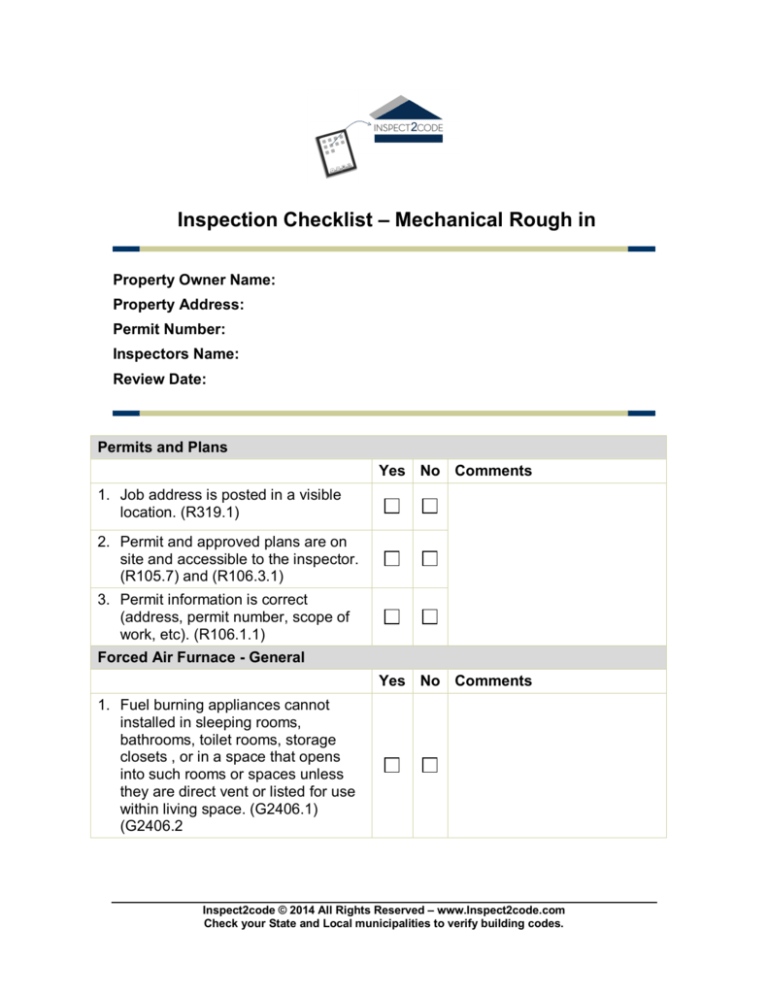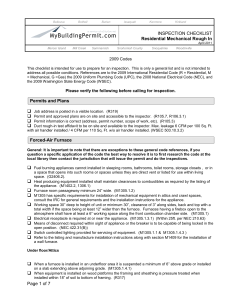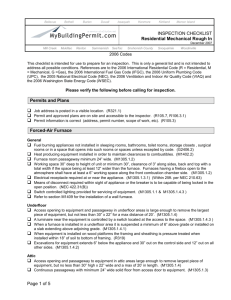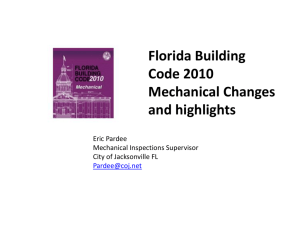
Inspection Checklist – Mechanical Rough in
Property Owner Name:
Property Address:
Permit Number:
Inspectors Name:
Review Date:
Permits and Plans
Yes No Comments
1. Job address is posted in a visible
location. (R319.1)
2. Permit and approved plans are on
site and accessible to the inspector.
(R105.7) and (R106.3.1)
3. Permit information is correct
(address, permit number, scope of
work, etc). (R106.1.1)
Forced Air Furnace - General
Yes No Comments
1. Fuel burning appliances cannot
installed in sleeping rooms,
bathrooms, toilet rooms, storage
closets , or in a space that opens
into such rooms or spaces unless
they are direct vent or listed for use
within living space. (G2406.1)
(G2406.2
Inspect2code © 2014 All Rights Reserved – www.Inspect2code.com
Check your State and Local municipalities to verify building codes.
Inspection Checklist – Mechanical Rough in
2. Heat producing equipment installed
shall maintain clearances to
combustibles as required by the
listing of the appliance. (M1402.2)
(M1306.1)
3. Furnace room passageway
minimum 24” wide. (M1305.1.2)
4. Minimum working space around
furnace or air handlers is 3 inches.
Firebox open to the atmosphere
shall have a minimum 6 inch
working space along the front
combustion chamber side.
(M1305.1.1)
5. Electrical receptacle is required at or
near the appliance. (M1305.1.3.1)
6. Switch controlled lighting provided
for servicing of equipment.
(M1305.1.4.3)
Forced Air Furnace - Under floor /Attics
Yes No Comments
1. When a furnace is installed in an
underfloor area it is suspended a
minimum of 6” above grade or
installed on a slab extending above
adjoining grade. (M1305.1.4.1)
2. When equipment is installed on
wood platforms the framing and
sheathing is pressure treated when
installed within 18” of soil to bottom
of framing. (R317.1)
3. Excavations for equipment have
specific requirements. Check the
installation instructions for minimum
requirements (M1305.1.4.2)
Forced Air Furnace – Garage
Yes No Comments
1. Equipment which has a flame,
generates a spark or uses a glowing
Inspect2code©2014
Page 2
WWW.INSPECT2CODE.COM
Inspection Checklist – Mechanical Rough in
ignition source is open to the space
in which it is installed and is
elevated such that the source of
ignition is at least 18” above the
floor. §(M1307.3)
2. Ducts which penetrate a wall or
ceiling separating the garage from
the dwelling are 26 gauge with no
openings to the garage. (R302.5.2)
3. Bollard or wheel stop required in
front of or to the side of equipment if
subject to impact by automobile.
(M1307.3.1)
Condensing Furnace (High Efficiency)
Yes No Comments
1. Condensate drain required to drain
by gravity to an approved drain or
condensate pump. (M1411.3)
2. Drain pipe minimum 3/4” with 1/8”/ft.
slope. (Per manufacturer’s
installation instructions, and
(M1411.3.2)
Ducting - General
Yes No Comments
1. Two story maximum vertical rise on
factory made duct. (M1601.4.6)
2. Duct to ground minimum 4”
clearance. (M1601.4.7)
3. Duct in or under concrete, encased
in a minimum 2” of concrete.
(M1601.1.2)
4. Round ducts have crimped joints
lapped minimum 1 inch and
fastened with (3) sheet-metal
screws or rivets equally spaced
around the joint. §(M1601.4.1)
5. Joints, seams, and fittings of ducts
sealed with mastic or other
approved means. §(M1601.4.1)
Inspect2code©2014
Page 3
WWW.INSPECT2CODE.COM
Inspection Checklist – Mechanical Rough in
6. Flex duct supported per
manufacturer’s specifications
(M1601.4.3)
7. Metal duct minimum support every
10’. (M1601.4.3)
8. Venting systems shall not extend
into or pass through any fabricated
air duct or furnace plenum.
(G2427.3.4)
Ducting - Return Air
Yes No Comments
1. Return air taken from a room or
space >25% of the total volume
served. See item #3. (M1602.2)
2. Cannot be taken from bathroom,
kitchen, toilet room, mechanical
room, closet, furnace room, other
dwelling unit, or garage. See item
#4. §(M1602.2)
3. Return air inlets not located within
10’ of any fuel burning appliance fire
box or draft hood located in the
same space. See item #5.
§(M1602.2)
4. Minimum return air duct size is 2
sq.in./kBtu/hr. output rating of the
furnace or as otherwise specified by
the manufacturer. (G2442.2)
5. Building cavities may not be used as
ducts (N1103.2.3)
6. Venting systems shall not extend
into or pass through any fabricated
air duct or furnace plenum.
(G2427.3.4)
Combustion Air
Yes No
Comments
1. The minimum cross section
dimension for combustion air
ducting is 3” (M1701.1) and
(G2407.6)
Inspect2code©2014
Page 4
WWW.INSPECT2CODE.COM
Inspection Checklist – Mechanical Rough in
2. Venting systems shall not extend
into or pass through any fabricated
air duct or furnace plenum.
(G2427.3.4)
3. Combustion air ducts cannot be
screened when terminating in an
attic space. See item #5.
(G2407.11) and (M1701.1)
4. In buildings of unusually tight
construction, combustion air shall be
obtained from outside the building.
(M1701.1) (G2407.1)
5. Indoor combustion air openings each opening shall be 1 sq. in. per
1,000 Btu/h input of all appliances,
but not less than minimum of 100
square inches (M1701.1) and
(G2407.5.3.1)
6. Two permanent combustion air
openings shall communicate directly
/ freely with the outdoors. (M1701.1)
(G2407.6.1)
7. Where two vertical ducts are used to
provide combustion air from the
outdoors, each opening requires 1
sq. in. of opening per 4,000 Btu/h of
total input rating of all appliances in
the space. (M1701.1) (G2407.6.1)
8. Where two horizontal ducts are
used, each opening requires 1 sq.
in. of opening per 2,000 Btu/h of
total input rating of all appliances in
the space. (M1701.1) (G2407.6.1)
9. When the one opening method is
used the opening requires 1 sq. in.
of opening per 3,000 Btu/h of total
input rating of all appliances in the
space and be within the top 12” of
the space. The openings shall
communicate directly / freely with
the outdoors. (M1701.1)
(G2407.6.2)
Inspect2code©2014
Page 5
WWW.INSPECT2CODE.COM
Inspection Checklist – Mechanical Rough in
10. Outside combustion air openings
are to be screened with ¼ to ½ inch
mesh corrosion-resistant material.
(M1701.1) (G2407.10)
11. Combustion air may be drawn from
inside the building if of ordinary
tightness and the conditioned space
is greater than 50 cubic feet per
1,000 Btu/h input for all fuel burning
appliances combined (M1701.1)
(G2407.5.1)
Vents and Connectors
Yes No
Comments
1. Venting systems are to be
adequately supported for the weight
of the material used. (M1801.7)
(G2427.6.9)
2. Where two gas appliances are
vented through a common vent
connector it is equal to largest
connector plus 50% of the smaller
flue outlet and not less than the
combined area of the flue outlets for
which it acts as a common
connector. (G2427.10.3.4)
3. Vent connector clearances to
combustibles per manufacturer’s
listing or performance standards.
(M1803.3.4) (M1306.1) (G2427.7.8)
4. Single wall vents cannot penetrate a
wall, floor or ceiling without a listed
pass through assembly, except for
gas vents - exterior combustible
walls only – with a “ventilated metal
thimble”. (M1801.1) (G2427.7.7)
5. Vent terminations installed per the
manufacturer’s listing. (M1804.2)
(G2427.6.3)
Inspect2code©2014
Page 6
WWW.INSPECT2CODE.COM
Inspection Checklist – Mechanical Rough in
6. Exhaust vent terminations for
mechanical draft and direct venting
correct distance from a door,
operable window or a gravity air
inlet into a building. §(M1804.2.6)
(G2427.8)
7. Gas vent terminations for listed
caps, for roof / wall size and
clearances. Gas vents < 12”, and
not less than 8’ from vertical wall or
obstruction, shall terminate above
roof per table (pitch of roof). Gas
vents > 12” shall terminate 2’ above,
and 10’ away from roof. (G2427.6.3)
8. Vent terminal (except direct-vents)
not mounted directly above or within
3’ horizontally of a gas meter or oil
tank. §(M1804.2.6)
9. Vent terminal no closer than 3’ to an
interior corner formed by (2)
perpendicular walls. §(M1804.2.6)
10. Power exhaust terminals not located
within 10’ of property line and
adjacent buildings, and 7’ above any
finished ground level public
walkway. (M1804.2.6 / G2427.3.3)
11. Venting systems shall not extend
into or pass through any fabricated
air duct or furnace plenum.
(G2427.3.4)
12. A chimney or vent connector shall
not pass through any floor or wall
ceiling, and shall not pass through a
wall or partition unless the
connector is listed and labeled for
wall pass-through, and installed per
the listing. (M1803.3.1) (G2427.7.6)
Inspect2code©2014
Page 7
WWW.INSPECT2CODE.COM
Inspection Checklist – Mechanical Rough in
13. Where vents extending into an attic
pass through insulated assemblies,
an insulation shield of 26 gage
sleeve not less than 2 inches above
the insulation, secured in place and
shall be installed to provide
clearance between the vent and the
combustible insulation materials,
specified by the vent manufacturer.
(G2426.4)
14. Venting supported per
manufacturer’s listing. (M1801.1)
(M1801.7)
Appliances – Clothes Dryers
Yes No
Comments
1. Exhausted per manufacturer’s
instructions. (M1502.1) (G2439.1)
2. Clothes dryer exhaust ducts of
metal with smooth interior surfaces,
with joints running in the direction of
air flow. (M1502.4) (G2439.5)
3. Protective shield steel plates of
0.062 thickness, where nails or
screws are likely to penetrate
clothes dryer exhaust duct – incl. @
framing members < 1-1/4” between
duct and finished face of framing
member. (M1502.5) (G2439.5.3)
4. No screws used to attach connector
to duct. §(M1502.4.2) (G2439.5.2)
5. Duct connector 4” minimum or
appliance outlet size. §(M1502.4.1)
(G2439.5)
6. Dryer duct correct length.
(M1502.4.4) (G2439.5.5)
7. Clothes dryer ducting run
independently of other ducted
systems, and shall convey moisture
to the outdoors (except listed and
labeled condensing ductless clothes
dryers). (M1502.2) (G2439.1)
Inspect2code©2014
Page 8
WWW.INSPECT2CODE.COM
Inspection Checklist – Mechanical Rough in
8. Exterior termination is backdraft
dampered, with no screens, and 3’
min. from away from any openings
into building. Clothes dryer exhaust
ducts shall not connect to: vent
connectors; vent; or chimney.
(M1502.3) (G2439.3)
9. Clothes dryer ducting concealed in
construction must be labeled with
the equivalent length. Label shall be
located within 6’ of the exhaust
connection. (M1502.4.5)
(G2439.5.6)
10. Dryer exhaust duct required at time
of occupancy. If dryer not installed,
exhaust duct shall be capped at the
location of the future dryer (except
listed and labeled condensing
ductless clothes dryers) (M1502.4.6)
(G2439.5.7)
11. Electric dryer transition duct shall be
single length, listed and labeled, UL
2158A, and maximum length 8’
long. Transition ducts shall not be
concealed within construction.
(M1502.4.3) (G2439.5.4)
12. Gas dryer gas connectors maximum
6’ long, measured along centerline
of the connector. One connector
only. (G2422.1.2.1)
13. Gas shutoff valve installed
immediately ahead of connector,
and in the same room.
(G2422.1.2.4)
Appliance - Range
Yes No
Comments
1. Vertical clearance to combustibles is
30” minimum or per manufacturer’s
listing. Minimum clearance reduced
to 24” (Gas cooking appliance) with
one of three exceptions. §(M1901.1)
(G2447.5)
Inspect2code©2014
Page 9
WWW.INSPECT2CODE.COM
Inspection Checklist – Mechanical Rough in
2. Gas connector maximum 6’ long
maximum. (G2422.1.2.1)
3. Shutoff valve installed immediately
ahead of connector. (G2422.1.2.4)
Appliance – Range Hood Duct
Yes No
Comments
Yes No
Comments
1. Terminates outside, is air tight and
is equipped with a backdraft
damper. §(M1503.1)
2. Ducting is galvanized steel,
stainless steel, or copper, with a
smooth interior. Exception: Ducts for
domestic cooking appliances
equipped with downdraft exhaust
system, can be schedule 40 PVC,
and comply with all 5 exception
requirements. (M1503.2)
3. Domestic open-top broiler units shall
have a metal exhaust hood, having
a minimum thickness of 28 gauge
with ¼” clearance between hood
and the underside of combustible
materials or cabinets, and clearance
of min. 24” between cooking surface
to combustible materials or
cabinets, unless listed and labeled
for broiler units with integral exhaust
system. (M1505.1)
Appliances - Fireplaces
1. Factory built fireplaces certified,
listed and labeled. (R1004.1)
2. Masonry and Concrete fireplaces,
and heaters – listed and labeled.
(M1415.1)
Inspect2code©2014
Page 10
WWW.INSPECT2CODE.COM
Inspection Checklist – Mechanical Rough in
3. Exterior intake capable of supplying
all combustion air from exterior. Not
located within the garage or
basement or at an elevation higher
than the firebox. (R1006.2)
4. Hearth extensions are to be readily
distinguishable from the surrounding
floor and in accordance with the
fireplace listing. §(R1004.2)
5. Decorative appliances in fireplaces
installed per manufacturer’s
installation instructions. (G2432.1)
6. Appliance shutoff valves shall be
located in the same room, and
within 6’ of the appliance. Appliance
shutoff valves located in fireplace
firebox shall be installed per the
appliance manufacturer’s
instructions. (G2420.5)
7. Shutoff valves for vented decorative
appliances and room heaters shall
be permitted to be installed in a
remote area from the appliance
where such valves are provided
with: ready access; permanent
identification; and serve no other
appliance. Shutoff valve installed at
a manifold – within 50’ of appliance,
but other req’s apply, as above.
(G2420.5.2)
8. Decorative shrouds used at chimney
terminations are to be listed and
labeled for use with specific
chimney system. (R1004.3)
(R1005.2)
Appliances – Air Conditioning
Yes No
Comments
1. Cooling coils installed downstream
(return side) from heat exchanger.
(M1411.2)
2. Working space around appliance is
a minimum 30” x 30”. (M1305.1)
Inspect2code©2014
Page 11
WWW.INSPECT2CODE.COM
Inspection Checklist – Mechanical Rough in
3. Condensate disposal line to an
approved place of disposal, but not
to public street, alley, or create a
nuisance. (M1411.3)
4. Auxiliary and secondary drain
systems (incl. pan) in addition to
condensate disposal, where
damage to any building components
will occur from overflow or stoppage
of condensate drain piping are
present. (M1411.3.1)
5. Condensate sloped to drain – 1/8
unit in 12 units (1-percent slope).
(M1411.3)
6. Refrigerant lines are to be pressure
tested prior to start up of the
compressor if required by
manufacturer’s installation
instructions for residential systems,
or when piping is brazed. (M1404.1)
and (M1411.1)
7. Refrigerant lines shall be insulated
to R-4, and perm rating of max.
0.05. (M1411.5)
8. Refrigerant circuit access ports shall
be fitted with the locking-type
tamper-resistant caps. (M1411.6)
Exhaust Venting
Yes No
Comments
1. Source specific ventilation fans are
required in kitchens, bathrooms,
water closet rooms, laundry rooms
and indoor swimming pools, spas,
or other rooms where water vapor or
cooking odor is produced.
§(M1507.1) and §(M1507.3.1)
2. Bathroom fans 50 cfm minimum,
and kitchen fans 100 cfm minimum.
§(M1507.3.1)
Inspect2code©2014
Page 12
WWW.INSPECT2CODE.COM
Inspection Checklist – Mechanical Rough in
General Comments:
Inspect2code©2014
Page 13
WWW.INSPECT2CODE.COM











